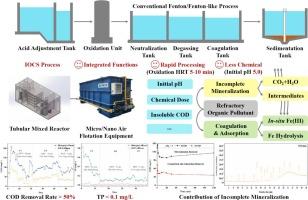中试管式混合反应器在短水力停留时间下去除工业废水中的难降解有机污染物:效果与机理
IF 6.7
2区 工程技术
Q1 ENGINEERING, CHEMICAL
引用次数: 0
摘要
采用中试管式混合反应器和微纳气浮设备,研究了不完全氧化-混凝-絮凝-分离工艺对工业废水深度处理的效果。通过化学需氧量(COD)、pH和H2O2浓度的变化、x射线衍射(XRD)、傅里叶变换红外光谱(FTIR)、紫外可见光谱(UV-Vis)、凝胶渗透色谱(GPC)和气相色谱/串联四极杆飞行时间质谱(GC/QTOF-MS)分析,探讨了潜在的机制。当初始pH升高至5.0,氧化水力停留时间(HRT)缩短至5-10 min时,在不引入预制备催化剂的情况下,IOCS工艺的COD平均去除率超过50%,总磷降至极低水平(0.1 mg/L)。矿化去除率最多仅占总COD的26.3% ~ 34.4%,而IOCS去除率最多占73.1% ~ 86.7%。在最初的2-5分钟内,pH值从5.0急剧下降到3.5左右,H2O2的消耗迅速增加了95%,这与铁水解和随后的氧化和吸附增强有关。此外,FTIR和GC/QTOF-MS分析证实了难降解有机污染物的不完全矿化,其中间体积聚在IOCS污泥中。原位生成的Fe(III)可能在除磷和有机污染物中发挥了不可或缺的作用。本研究提出了一种新的污水深度处理方法,强调快速处理、功能集成和最小的化学投入。本文章由计算机程序翻译,如有差异,请以英文原文为准。

Refractory organic pollutants removal in industrial wastewater by a pilot-scale tubular mixed reactor at short hydraulic retention time: Effect and mechanism
This study investigates the efficiency of incomplete oxidation-coagulation/flocculation-separation (IOCS) process for industrial wastewater advanced treatment using pilot-scale tubular mixed reactor and micro/nano air flotation equipment. The underlying mechanism was explored through variations in chemical oxygen demand (COD), pH and H2O2 concentration, X-ray diffraction (XRD), Fourier transform infrared spectroscopy (FTIR), ultraviolet-visible spectroscopy (UV–Vis), gel permeation chromatography (GPC), and gas chromatography/tandem quadrupole time-of-flight mass spectrometry (GC/QTOF-MS) analyses. The IOCS process achieved an average COD removal rate exceeding 50 % and reduced total phosphorus to extremely low levels (< 0.1 mg/L), when the initial pH was elevated to 5.0 and the oxidation hydraulic retention time (HRT) was shortened to 5–10 min without the introduction of pre-prepared catalysts. Mineralization removal only contributed at most 26.3 %–34.4 % of total COD, whereas IOCS removal accounted for at most 73.1 %–86.7 %. A sharp pH drop from 5.0 to approximately 3.5 and rapid H2O2 consumption by >95 % were observed within the first 2–5 min, associated with iron hydrolysis and subsequently enhanced oxidation and adsorption. Furthermore, FTIR and GC/QTOF-MS analyses confirmed the incomplete mineralization of refractory organic pollutants, with their intermediates accumulating in the IOCS sludge. In-situ generated Fe(III) likely played an indispensable role in phosphorus and organic pollutants removal. This study proposes a novel approach to wastewater advanced treatment, emphasizing rapid processing, functional integration, and minimal chemical input.
求助全文
通过发布文献求助,成功后即可免费获取论文全文。
去求助
来源期刊

Journal of water process engineering
Biochemistry, Genetics and Molecular Biology-Biotechnology
CiteScore
10.70
自引率
8.60%
发文量
846
审稿时长
24 days
期刊介绍:
The Journal of Water Process Engineering aims to publish refereed, high-quality research papers with significant novelty and impact in all areas of the engineering of water and wastewater processing . Papers on advanced and novel treatment processes and technologies are particularly welcome. The Journal considers papers in areas such as nanotechnology and biotechnology applications in water, novel oxidation and separation processes, membrane processes (except those for desalination) , catalytic processes for the removal of water contaminants, sustainable processes, water reuse and recycling, water use and wastewater minimization, integrated/hybrid technology, process modeling of water treatment and novel treatment processes. Submissions on the subject of adsorbents, including standard measurements of adsorption kinetics and equilibrium will only be considered if there is a genuine case for novelty and contribution, for example highly novel, sustainable adsorbents and their use: papers on activated carbon-type materials derived from natural matter, or surfactant-modified clays and related minerals, would not fulfil this criterion. The Journal particularly welcomes contributions involving environmentally, economically and socially sustainable technology for water treatment, including those which are energy-efficient, with minimal or no chemical consumption, and capable of water recycling and reuse that minimizes the direct disposal of wastewater to the aquatic environment. Papers that describe novel ideas for solving issues related to water quality and availability are also welcome, as are those that show the transfer of techniques from other disciplines. The Journal will consider papers dealing with processes for various water matrices including drinking water (except desalination), domestic, urban and industrial wastewaters, in addition to their residues. It is expected that the journal will be of particular relevance to chemical and process engineers working in the field. The Journal welcomes Full Text papers, Short Communications, State-of-the-Art Reviews and Letters to Editors and Case Studies
 求助内容:
求助内容: 应助结果提醒方式:
应助结果提醒方式:


